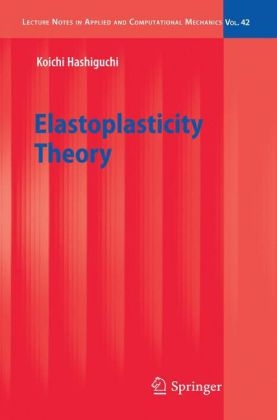Elastoplasticity Theory
Seiten
2009
Springer Berlin (Verlag)
978-3-642-00272-4 (ISBN)
Springer Berlin (Verlag)
978-3-642-00272-4 (ISBN)
- Titel erscheint in neuer Auflage
- Artikel merken
Zu diesem Artikel existiert eine Nachauflage
This book details the mathematics and continuum mechanics necessary as a foundation of elastoplasticity theory. It explains physical backgrounds with illustrations and provides descriptions of detailed derivation processes.
This book was written to serve as the standard textbook for instruction of elastoplasticity theory. It opens with an explanation of the mathematics and continuum mechanics which are necessary as a foundation of elastoplasticity theory. Subsequently, conventional and unconventional elastoplasticity theories are explained comprehensively for description of general loading behavior covering monotonic, nonproportional, and cyclic loading processes. Fundamental notions such as continuity and smoothness conditions, decomposition of deformation into elastic and plastic parts, the associated flow rule, the loading criterion and the anisotropy are defined, and then presented with their mechanical interpretations. Explicit constitutive equations of metals and soils, which are useful in engineering practice for the mechanical design of machinery and structures, are also introduced. Moreover, constitutive equations of friction with transition from static to kinetic friction and vice versa, and rotational and orthotropic anisotropy are provided. They are indispensable for analyses of boundary-value problems.
A distinguishing feature of this book is that it is written to be understandable without difficulty even by beginners in the field of elastoplasticity, explaining physical backgrounds with illustrations and descriptions of detailed derivation processes without a jump. Furthermore, the history and the latest results related to elastoplasticity are explained thoroughly to the extent that the fundamentals of elastoplasticity theory can be understood and be applicable readily to analyses of engineering problems.
This book was written to serve as the standard textbook for instruction of elastoplasticity theory. It opens with an explanation of the mathematics and continuum mechanics which are necessary as a foundation of elastoplasticity theory. Subsequently, conventional and unconventional elastoplasticity theories are explained comprehensively for description of general loading behavior covering monotonic, nonproportional, and cyclic loading processes. Fundamental notions such as continuity and smoothness conditions, decomposition of deformation into elastic and plastic parts, the associated flow rule, the loading criterion and the anisotropy are defined, and then presented with their mechanical interpretations. Explicit constitutive equations of metals and soils, which are useful in engineering practice for the mechanical design of machinery and structures, are also introduced. Moreover, constitutive equations of friction with transition from static to kinetic friction and vice versa, and rotational and orthotropic anisotropy are provided. They are indispensable for analyses of boundary-value problems.
A distinguishing feature of this book is that it is written to be understandable without difficulty even by beginners in the field of elastoplasticity, explaining physical backgrounds with illustrations and descriptions of detailed derivation processes without a jump. Furthermore, the history and the latest results related to elastoplasticity are explained thoroughly to the extent that the fundamentals of elastoplasticity theory can be understood and be applicable readily to analyses of engineering problems.
Tensor Analysis.- Motion and Strain (rate).- Conservation Laws and Stress Tensors.- Objectivity and Corotational Rate Tensor.- Elastic Constitutive Equations.- Basic Formulations for Elastoplastic Constitutive Equations.- Unconventional Elastoplasticity Model: Subloading Surface Model.- Cyclic Plasticity Model: Extended Subloading Surface Model.- Viscoplastic Constitutive Equations.- Constitutive Equations of Metals.- Constitutive equations of soils.- Corotational Rate Tensor.- Localization of Deformation.- Return Mapping Method.- Constitutive Equation for Friction.
| Reihe/Serie | Lecture Notes in Applied and Computational Mechanics |
|---|---|
| Sprache | englisch |
| Maße | 155 x 235 mm |
| Gewicht | 1730 g |
| Einbandart | gebunden |
| Themenwelt | Technik ► Maschinenbau |
| Schlagworte | Constitutive equation of friction • Constitutive equations of metals and soils • Elastoplastic constitutive equation • Viscoplastic constitutive equation |
| ISBN-10 | 3-642-00272-2 / 3642002722 |
| ISBN-13 | 978-3-642-00272-4 / 9783642002724 |
| Zustand | Neuware |
| Informationen gemäß Produktsicherheitsverordnung (GPSR) | |
| Haben Sie eine Frage zum Produkt? |
Mehr entdecken
aus dem Bereich
aus dem Bereich
Normung, Berechnung, Gestaltung
Buch | Softcover (2023)
Springer Vieweg (Verlag)
39,99 €
Buch | Softcover (2023)
Springer Vieweg (Verlag)
24,99 €
Buch | Softcover (2023)
Springer Vieweg (Verlag)
24,99 €





